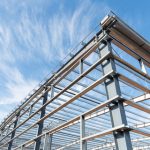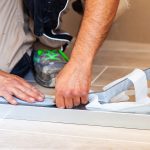It’s not enough to select the right fastener to secure metal roof panels. To prevent roof failures and maintenance issues, contractors must also choose the right power tool to drive those fasteners.
Screw guns are the contractor’s best bet for metal roof installations

For the installation of a metal roof, contractors are urged to use a screw gun with a clutch to prevent the over-driving of fasteners.(Photo courtesy of Lakeside Construction Fasteners)
Although drills and impact drivers are used as well as screw guns to drive metal fasteners, “A real screw gun with an adjustable clutch is the best tool overall,” says Ed Lash, product manager for Atlas Bolt & Screw Co., Ashland, Ohio. “With a drill, when you let go of the trigger it doesn’t disengage the driver as does a screw gun with a depth-sensitive nose piece.”
Ken Webb, sales manager for Dynamic Fastener, Kansas City, Mo., agrees, “A screw gun, not a drill or impact driver, is what you need.”
Eric Velliquette, vice president of sales and marketing for Lakeside Construction Fasteners, Marion, Ohio, says he would never recommend a drill to install metal fasteners. “Screw guns are designed for setting the torque and, in some cases, the drill speed of the gun,” he says.
Improved screw-gun technology has resulted in tools that are lighter in weight and have a longer battery life and increased rpm speeds. Fasteners, too, are being manufactured to align with that technology, Velliquette adds.

DeWalt’s DCF622M2 20V Max KR Cordless Versa Clutch screw gun is a popular choice for driving metal fasteners. (Photo courtesy of Dynamic Fastener)
Screw Guns, Drills and Impact Drivers
Specialty screw guns, cordless or battery-powered drills, and impact drivers are all used to drive metal roof fasteners. Screw guns—conventional 110-volt corded tools that usually require extension cords to reach from the power source to the job site—have a torque-controlled, depth-setting feature or a simple nosepiece design to release the screw as it seats itself to a predetermined depth (i.e., flush with the roof panel) and eliminate screws not seating flush with the panel. The extension cord requirement is a disadvantage, but once the depth has been set, anyone can operate the tool and obtain perfectly seated fasteners each time.
Cordless and battery-powered drills allow the user to insert a drive socket into the chuck used to hold the drill bit and then employ the tool to drive small-diameter screws. They’re portable, don’t require a power cord and don’t need to be near a power source. However, the operator must release the trigger switch at just the right time to prevent over-driving and damaging the panels—or under-driving and having to go back to fully seat the fastener flush to the work surface.
Impact drivers are the most recent development in tools that drive small-diameter fasteners. They were originally designed for use with hex-head fasteners or to facilitate driving steel nuts onto machine screws using a hit-and-turn motion. With each revolution, the driver bit pulses or is shocked (hit) many times as the tool turns at speeds that may be higher than the 1,200-1,800 rpm recommended for metal-to-wood connections.
While impact drivers are high-torque, high-speed tools that offer advantages, if used by inexperienced operators they can result in damaged panels, broken screws, and scratched paint or powder coatings.
“Recently, many contractors have been using impact drivers for almost all metal roofing applications,” says Steve Butler, sales manager for Dynamic Fastener. “These tools do not have a clutch to prevent over-driving of the fasteners, which leads to washers being over-compressed and in turn, leakage. It’s always a good practice to use a screw gun with some type of clutch to prevent over-driven screws on metal roofs.”
For metal fastening, a good rule of thumb is the thicker the material, the lower the rpm and the higher the torque required. Webb says a 1,000-rpm, high-torque screw gun is ideal for fastening T5 self-drilling screws into steel that is 1/4-inch thick or thicker. “If you use a 2,500-rpm screw gun to drive fasteners into steel of this thickness, then you will prematurely burn up the motor, as well as the points of your screws,” he says. However, a 2,500-rpm screw gun would be appropriate for installing self-drilling screws with T1 and T3 drill points.
Screw guns with higher rpms (2,800 to 3,500) are available, but bigger isn’t always better. “Going to a high-rpm screw gun doesn’t mean that installing fasteners will go quicker,” warns Velliquette. “The fastener must be able to penetrate through the metal panel into the base substrate, but at the same time it’s being seated, you want to avoid stripping the fastener out or causing the shank to fracture, which will increase leaks over time.”
Nut Setters, Nut Drivers and Nut Runners
A nut setter, also known as a nut driver or nut runner depending on what part of the United States you’re in, is a tool for tightening nuts and bolts that consists of a socket attached to a shaft and a cylindrical handle. Choosing the right nut setter for a metal roof installation is critical, says Velliquette. It goes without saying that contractors are advised to select high-quality tools.
“Not all nut setters are manufactured to the same tolerances, and nut setter specifications can be different from one manufacturer to the next, affecting job-site performance,” he says.
Velliquette suggests that when selecting the right net setter, contractors should take the fastener along so an appropriate tool/fastener match can be made. Some manufacturers expedite the process by offering a nut setter that is designed specifically for certain metal fasteners.
Nut setters and bits should be replaced when worn. “[Bits] are relatively inexpensive, and a worn bit can cause more issues than the small additional cost is worth,” says Lash. How do you know when it’s time to replace a bit? “When the nut setter doesn’t properly engage on the head of the fastener it could be worn internally, which could cause it to spin and prevent installation,” says Webb.
Nut setters are available with a magnet that helps align a carbon steel screw when fastening. Contractors need to ensure that this magnet is set correctly, says Velliquette. “I’ve been to many job sites where the fastener wobbles or slips out of the nut setter, scratching the surface of the metal panel during installation,” he says. “This was due to the magnet being set too high.”
Velliquette offers this rule of thumb for using a new nut setter: set the height of the magnet to the height of the fastener hex head. This can be done simply by taking the fastener head, placing it into the nut setter and tapping on the fastener shank until the hex washer is flush with the opening of the nut setter.
Keep the magnet free of metal chips as they prevent the screw from being seated properly and can scratch the paint on the screw heads. “I’ve seen nut setters used over and over again, filled with metal shavings, while observing broken magnets inside of them,” Velliquette says. “Once this happens, trying to drive a fastener into a metal panel will be extremely difficult.”
He recommends doing periodic maintenance on tools used at the job site. It can be a simple as pushing a piece of butyl tape into the opening of the nut setter and pulling the tape back out. This will extract most of the metal shavings and “extend the life of your nut setter out in the field,” Velliquette says.
A new initiative that Dynamic Fasteners addressed in 2018 was to obtain very high-quality magnetic nut runners, in many different lengths, says Webb. “The longer lengths are beneficial when the contractor is working in tight quarters and the front of the screw gun gets in the way of the application,” he says. Ultra-Premium Impact-Tested Nut Runners are available in five different lengths: 1 3/4 inches, 2 9/16 inches, 4 inches, 6 inches and 12 inches. Both magnetic and nonmagnetic versions are available.
Speed Things Up with Auto Feed
Auto-feed screw driving systems are efficient for applications like metal roofing where large numbers of fasteners are installed. These systems drive collated strips of fasteners. They don’t require special training, are easy to operate, and provide an ergonomic, stand-up installation method that reduces back and knee strain.
“The collated strips increase the contractor’s productivity in that there is less handling of individual fasteners and fewer dropped fasteners, and therefore less waste of time and materials,” says Robert Shirley, product marketing manager for Simpson Strong-Tie, Pleasanton, Calif.
Auto-drive systems are designed to drive fasteners with specific combinations of features (size, length, diameter, head type, etc.) and according to the type of material being installed. Be sure to choose an auto-drive system specifically intended for metal-to-metal connections, Shirley says.
To prevent over- or under-driving a fastener, the proper driving depth needs to be attained and maintained. An auto-drive system provides an adjustable depth gauge to help contractors consistently maintain the right depth.
Auto-feed systems are currently used, for the most part, on pre-engineered, metal-to-metal buildings, Velliquette says. “With post-frame, metal-to-wood buildings, the cost of the fasteners and auto-feed tool tends to be prohibitive,” he says. “However, as auto-feed technologies become less expensive, in time I do foresee them becoming the standard method of driving fasteners.”






